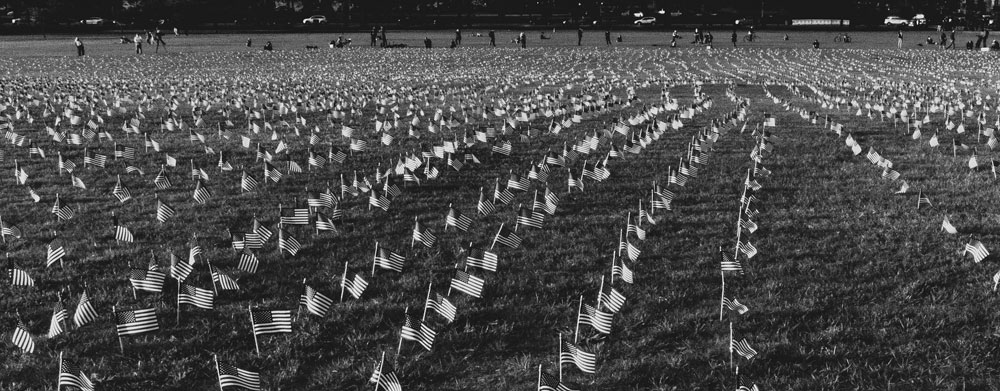
Here at NPQ, we have, from time to time, paused to reflect on the toll that COVID-19 has wrought, noting a few of the countless leaders in nonprofits and social movements who have fallen to the virus. Around Memorial Day, the virus’s toll in the US reached 100,000 lives lost, including activists such as longtime HIV-AIDS advocate Garry Bowie, director of Being Alive in West Hollywood, California; and Lorena Borjas, who had supported transgender women in the Queens borough of New York City. In mid-November, we paused again and lifted up a few more community leaders who had lost their lives to the virus, as the nation passed one quarter-million dead.
Throughout, there has been little official acknowledgement of the loss. Communities instead created makeshift memorials to honor the dead. Bethesda-based artist Suzanne Brennan Firstenberg, who organized a memorial of flags at RFK Stadium in Washington, DC, noted that, “This had to happen because people have nowhere to put their grief. They need society to acknowledge that they’ve lost a loved one.” The flags have since been taken down, but Firstenberg is working with George Washington University’s anthropology department to put together a digitalized recreation of her art installation.
This week, the nation passed 400,000 fatalities from COVID-19, and that number now tops 410,000. In a single year, the number of Americans who died from the virus outstretched the 407,316 US soldiers who died during the four years of its participation in World War II. The surge in deaths since November means that while it took nearly six months to go from 100,000 dead to 250,000 dead, it took only two more months for the death toll rise to 400,000.
In 2021, however, with a new president comes a very different response. The day before the Inauguration, President Joe Biden and Vice President Kamala Harris visited the Lincoln Memorial, where they participated in a short but moving public memorial, with 400 lights turned on to honor the 400,000 lost. As Peter Baker noted in the New York Times, “The evocative ceremony provided a moment of catharsis that the nation has not experienced until now.” Many other cities, including Seattle, Houston, and New York, joined in the commemoration.
The lack of official memorialization of COVID, at least until now, is not unprecedented. As Zachary Small of National Public Radio noted last month, “Despite 50 million people worldwide dying from an influenza virus a century ago…the 1918 flu pandemic is barely remembered in statues and stone.” But he adds, this failure to memorialize has come at a cost. “Some historians have suggested that the lack of memorials contributed to a mass amnesia around the disease, which in turn may have contributed to a lack of preparedness for the coronavirus pandemic,” Small writes.
Sign up for our free newsletters
Subscribe to NPQ's newsletters to have our top stories delivered directly to your inbox.
By signing up, you agree to our privacy policy and terms of use, and to receive messages from NPQ and our partners.
At the ceremony in Washington this past Tuesday, registered nurse Lori Marie Key, assigned to the COVID unit at St. Mary Mercy Livonia hospital in Michigan, sang the hymn “Amazing Grace,” a song she had sung before to comfort her coworkers. Livonia is located in Wayne County (county seat Detroit) and has alone seen 93,000 coronavirus cases. Prior to Key singing, Biden remarked, “If there are any angels in heaven, they’re all nurses. We know from our family experience what you do, the courage and pain you absorb for others.”
Sadly, the data show that many healthcare workers have been victims of the virus themselves. According to a database co-organized by Kaiser Health News and the Guardian, roughly eight of every 1,000 of COVID deaths in the US—3,248 people total—are frontline healthcare workers. Nearly a third of these (32 percent) are nurses. Another 19 percent served in various healthcare support roles. One in six (17 percent) are physicians. The remaining third serve in a range of roles. According to the database, 27 percent were Black, 33 percent were white, 22 percent were Asian and Pacific Islander, 15 percent were Latinx and two percent were American Indian.
Here are two recent cases:
- Michael “Flynnie” Flynn, a father of three, oversaw transport and laundry services at the nonprofit North Shore Medical Center in Salem, Massachusetts, where he transported many COVID patients. He came down with COVID and 10 days later, on December 8th, suffered a heart attack, deemed to have been caused by COVID, combined with hypertension and heart disease. He was 43.
- Damian Lopez retired from firefighting after 20 years in 2016. Afterward, he became a healthcare educator for the local hospital on the San Carlos Apache nation’s land in Arizona. When the pandemic hit, he helped install COVID-19 protocols and helped run the hospital’s COVID ward until his death. He was taken to a hospital for COVID on November 14th and died weeks later. He was 51.
Of course, while vaccination should ultimately stem the spread of the virus, currently the pace of deaths continues—some days topping 4,000 people in the US alone. How do you honor those who have parted, even as more continue to die?
Firstenberg, the Bethesda artist, acknowledges that labeling installations like hers as memorials is a questionable word choice, “because you don’t memorialize a plane crash in the middle of it crashing.” “But in time,” she adds hopefully, “I think we will find a magnificent way to honor all of our losses and to allow this to be a real pivot point in who we are as a country.”—Steve Dubb













